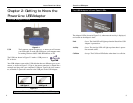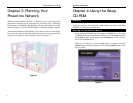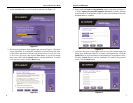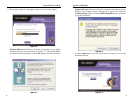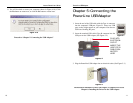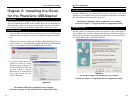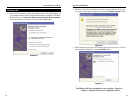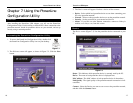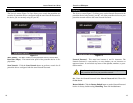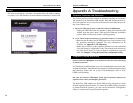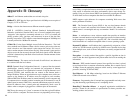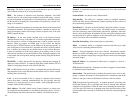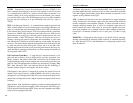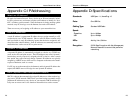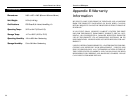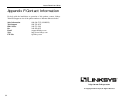
PowerLine USB Adapter
A different “plug-and-play” standard, FireWire/IEEE 1394, is designed to sup-
port much higher data rates and devices such as video camcorders and digital
video disk (digital versatile disk) players. Both standards are expected to exist
together, serving different device types.
UTP - Unshielded twisted pair is the most common kind of copper telephone
wiring. Twisted pair is the ordinary copper wire that connects home and many
business computers to the telephone company. To reduce crosstalk or electro-
magnetic induction between pairs of wires, two insulated copper wires are
twisted around each other. Each signal on twisted pair requires both wires.
Since some telephone sets or desktop locations require multiple connections,
twisted pair is sometimes installed in two or more pairs, all within a single
cable.
WINIPCFG - Configuration utility based on the Win32 API for querying,
defining, and managing IP addresses within a network. A commonly used util-
ity, under Windows 95, 98, and Millennium, for configuring networks with
static IP addresses.
27
Instant PowerLine
TM
Series
26
TCP/IP - Transmission Control Protocol/Internet Protocol (TCP/IP) is the
basic communication language or protocol of the Internet. It can also be used
as a communications protocol in a private network (either an intranet or an
extranet). When you are set up with direct access to the Internet, your comput-
er is provided with a copy of the TCP/IP program just as every other computer
that you may send messages to or get information from also has a copy of
TCP/IP.
UDP (User Datagram Protocol) - A communications method (protocol) that
offers a limited amount of service when messages are exchanged between com-
puters in a network that uses the Internet Protocol (IP). UDP is an alternative
to the Transmission Control Protocol (TCP) and, together with IP, is sometimes
referred to as UDP/IP. Like the Transmission Control Protocol, UDP uses the
Internet Protocol to actually get a data unit (called a datagram) from one com-
puter to another. Unlike TCP, however, UDP does not provide the service of
dividing a message into packets (datagrams) and reassembling it at the other
end. Specifically, UDP doesn't provide sequencing of the packets that the data
arrives in. This means that the application program that uses UDP must be able
to make sure that the entire message has arrived and is in the right order.
Network applications that want to save processing time because they have very
small data units to exchange (and therefore very little message reassembling to
do) may prefer UDP to TCP.
USB (Universal Serial Bus) - A “plug-and-play” interface between a com-
puter and add-on devices (such as audio players, joysticks, keyboards, tele-
phones, scanners, and printers). With USB, a new device can be added to your
computer without having to add an adapter card or even having to turn the com-
puter off. The USB peripheral bus standard was developed by Compaq, IBM,
DEC, Intel, Microsoft, NEC, and Northern Telecom and the technology is
available without charge for all computer and device vendors.
USB supports a data speed of 12 megabits per second. This speed will accom-
modate a wide range of devices, including MPEG video devices, data gloves,
and digitizers. It is anticipated that USB will easily accommodate plug-in tele-
phones that use Integrated Services Digital Network and digital private branch
exchange.
Since October, 1996, the Windows operating systems have been equipped with
USB driver or special software designed to work with specific I/O device types.
USB is integrated into Windows 98SE. Today, most new computers and periph-
eral devices are equipped with USB.



